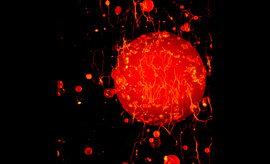Age, Diagnostic Category, Tumor Grade, and Mitosis-Karyorrhexis Index Are Independently Prognostic in Neuroblastoma: An INRG Project
PURPOSE The Children’s Oncology Group (COG) stratifies the treatment of patients with neuroblastoma on the basis of a combination of biomarkers that include age and tumor histology classified by age-linked International Neuroblastoma Pathology Classification (INPC) criteria. By definition, this leads to a duplication of the prognostic contribution of age. The individual histologic features underlying the INPC have prognostic strength and are incorporated in the International Neuroblastoma Risk Group classification schema. Here, we analyzed data in the International Neuroblastoma Risk Group Data Commons to validate the prognostic strength of the underlying INPC criteria and to determine whether a risk classification devoid of the confounding of age and INPC criteria will identify new prognostic subgroups. PATIENTS AND METHODS Event-free survival of patients diagnosed between 1990 and 2002 (cohort 1; n = 10,104) and between 2003 and 2016 (cohort 2; n = 8,761) was analyzed. Recursive partitioning with univariate Cox models of event-free survival (“survival tree regression”) was performed using (1) individual INPC criteria (age at diagnosis, histologic category, mitosis-karyorrhexis index (MKI), grade of differentiation) and (2) factors in (1) plus other COG-risk biomarkers (International Neuroblastoma Staging System [INSS] stage, MYCN status, ploidy). RESULTS The independent prognostic ability of age, histologic category, MKI, and grade were validated. Four histologic prognostic groups were identified (< 18 months with low v high MKI, and ≥ 18 months with differentiating v undifferentiated/poorly differentiating tumors). Compared with survival trees generated with established COG risk criteria, an additional prognostic subgroup was identified and validated when individual histologic features were analyzed in lieu of INPC. CONCLUSION Replacing INPC with individual histologic features in the COG risk classification will eliminate confounding, facilitate international harmonization of risk classification, and provide a schema for more precise prognostication and refined therapeutic approaches.


